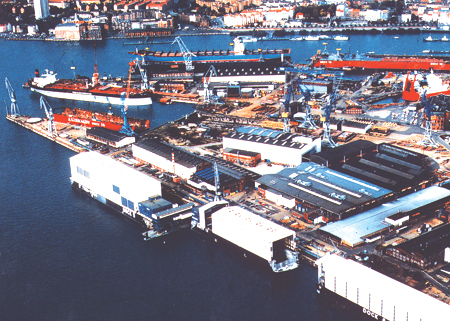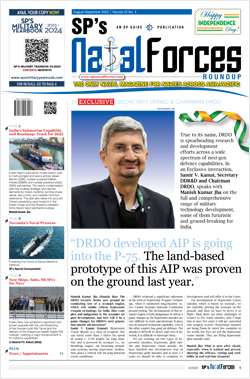INDIAN ARMED FORCES CHIEFS ON OUR RELENTLESS AND FOCUSED PUBLISHING EFFORTS

The insightful articles, inspiring narrations and analytical perspectives presented by the Editorial Team, establish an alluring connect with the reader. My compliments and best wishes to SP Guide Publications.

"Over the past 60 years, the growth of SP Guide Publications has mirrored the rising stature of Indian Navy. Its well-researched and informative magazines on Defence and Aerospace sector have served to shape an educated opinion of our military personnel, policy makers and the public alike. I wish SP's Publication team continued success, fair winds and following seas in all future endeavour!"

Since, its inception in 1964, SP Guide Publications has consistently demonstrated commitment to high-quality journalism in the aerospace and defence sectors, earning a well-deserved reputation as Asia's largest media house in this domain. I wish SP Guide Publications continued success in its pursuit of excellence.
Shipbuilding
Spotlight on Warships

Considering the cyclical nature of commercial shipbuilding, it would make good sense for commercial shipbuilding yards to devote some attention to naval shipbuilding.
Shipbuilding is considered a strategic industry for all maritime nations because of its immense potential to contribute towards both military and commercial objectives. In the recent past, with increasing demand for worldwide commerce and trade, the global shipbuilding market has been experiencing a particularly strong period. However, the current global economic turmoil has reduced the orders for new ships to a trickle due to slower demand as economies in the US and Europe weakens. Many shipyards across the world are now facing the real risk of cancellation of orders which will result in retention of surge capacities at a great cost to their own efficiencies and the customer’s price. This cyclical nature of shipbuilding industry, therefore, calls for innovative and adaptive technologies and processes to be adopted, if shipyards have to remain efficient and productive in both lean and boom periods.
Shipyard production technologies and business processes are significantly influenced by the types of ships being built in individual shipyards, the economies of scale, international rules and regulations as well as the strategies of individual shipyards and shipbuilding nations. This explains why plant equipment and production techniques used in different yards as well as the focus areas in research and development differ considerably. With Europe’s share in world shipbuilding decreasing rapidly, European yards have shifted focus on high value added complex ships, like cruise ships, with a high degree of outfitting, usually produced according to specific customer needs as single products or in small series. Accordingly, techniques for more efficient assembly and outfitting processes, modularisation, improved work sharing and supply chains have emerged from European yards. Japan, until a few years ago, was the world leader in shipbuilding through the utilisation of skilled technicians. Japan faced rapid loss of skills as skilled technicians got older and retired. Japanese shipbuilding industry has, therefore, pioneered in automation of production processes in shipyards.
In Korea, as shipyards tried to retain their world market share, the need to increase production capacity was pressing. The key issue in production technology in Korean shipyards was to increase production without building new dry docks, which required considerable investment. Some major technological breakthrough to build the vessels without using a dry dock has emanated from Korea. In US, since the commercial shipbuilding was not competitive to other Asian and European yards, the focus was on building warships. This has resulted in technologies and processes being developed in US shipyards that have led to the construction of some of the most complex and state-of-the-art warships.
Considering the cyclical nature of commercial shipbuilding, it would make good sense for commercial shipbuilding yards to devote some attention to naval shipbuilding, which is not as cyclic as the demand for commercial ships. Therefore, an attempt has been made, to highlight some of the core areas that leading warship building yards have focused on, to improve productivity so that better warships are built at shorter timeframes and lower costs.
Production technology
Production technologies involve all activities that transform raw materials, components and equipment into completed products. In recent years, the concept of precision manufacturing and lightweight construction has become increasingly more important. Precision manufacturing by means of laser cutting and welding has enabled production within very narrow tolerances, minimising assembly costs by removing the need for straightening and adjustments. Precision manufacturing is particularly notable for reducing rework and minimising throughput time at critical points, thereby increasing productivity.
Automation in shipbuilding has been applied almost exclusively in steel construction, particularly in cutting and welding. Shipyards are now addressing other perquisites such as design rationalisation, standard interim products, standard process definitions and design for automation to support and broaden automated shipbuilding processes. Curved panel welding, robotic painting and complex material handling are some of the areas that are brought into the ambit of automation.
Warship building encompasses a wide range of processes. Activities such as outfitting, system integration and testing have become increasingly important. Standardisation and modularisation of ship systems and sub-assemblies is seen today as the key to rationalise production. Better planning and process control facilitate Integrated Construction where up to 90 per cent of outfitting can be carried out at the block level, which shifts work out of the ship to workshops, where it can be performed in a more comfortable and controlled environment. Most of the reputed warship builders have infrastructure that is optimised for its product portfolio and facilities are constantly adapted to cutting edge production technologies. Leading shipyards now have roofed floating docks with integrated outfitting workshops that offer highly optimised conditions for final assembly and weather independent construction and launching of almost completely outfitted ships that are ready for the trial phase. Modern shipyards that have developed high level of standardisation, interface definitions and system engineering are using these skills to construct the same ship at two to three different locations so that production periods are vastly reduced.
The potential for process improvements to boost productivity is well established. Numerous methodologies are being implemented in many yards to accelerate innovation to products and processes. Six Sigma, Lean and Theory of Constraints have emerged as the dominant process improvement models of today. Momentum is gaining within the industry to apply these principles to the business processes that link the shipyard to its supplier and its customers. Lean/Six Sigma are not a set of manufacturing tools but a process improvement model with a focus on production flow, use of standardised methods, built-in quality, continuous process improvement and a high degree of involvement by flexible, motivated employees. These provide an established and successful medium to achieve shorter cycle times, lower costs and improved quality. Shipyards that have embraced these concepts have experienced dramatic return-on-investment and have also led to culture changes embraced by both management and the labour.





